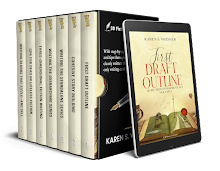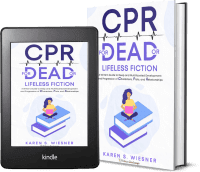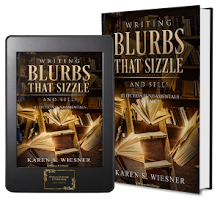Writer's Craft Article by Karen S. Wiesner
Advance Your Career:
Writing in Stages, Part 3
Based on CPR for Dead or Lifeless Fiction {A Writer's Guide to Deep and Multifaceted
Development and Progression of Characters, Plot, and Relationships}
This is the third of
four articles with techniques to advance your writing career.
In the previous part of this article, we talked
about the first three steps in writing in stages. Let's continue.
Stage 4:
Setting aside the project
You’ve probably noticed that three of the nine
(four if you use all eleven) stages are setting the project aside. Letting your
project sit, out of sight and out of mind, for a couple weeks--or even
months--in between stages will provide you with a completely fresh perspective.
Distance gives you objectivity and the ability to read your own work so you can
progress further with it, adding more layers and dimensions to your characters,
plots, and relationships. Another reason for setting projects aside between
stages is that writers may reach a point where their motivation lags, and they
want to abandon the story. Sometimes the author may not feel inspired to write
a book he's just spent weeks or even months outlining (note that I've never
spent more than 1-3 weeks outlining but other authors might not have the same
experience I have), just as he may not want to revise something he's spent
weeks or months writing.
Setting a project aside between the various
stages it goes through also allows your creativity to be at its peak. The
process becomes easier, too, and your writing will be the best it can be.
Putting a work-in-progress on a back burner for an extended period of time will
allow you to see more of the connections that make a story multidimensional.
To set your project aside between stages, return
everything to your story folder. Keep this book on a shelf and on the back
burner in your mind for as long as you possibly can. Get to work on something
else so you won’t concentrate too much on this project, making it the center of
your attention again.
As a general rule, every book I write gets a few
months between stages, a break I really need from each project. I can't imagine
going through all the steps in finishing a book back-to-back. I get so sick of
a story when one stage carries into the next without pause that I can no longer
see whether anything I'm doing is improving or ruining it. When one stage of a
work-in-progress is complete, I'm eager to get away from it. Many times I leave
a stage certain the whole thing is fit only for burning in the nearest
fireplace, but, when I come back to it months later, I discover that all my
previous hard work was well worth the effort.
Stage 5:
Writing the first draft
Once you take the project out to begin writing
the true first draft of the story, you’ll notice that you have everything you
need to begin. The outline you created for yourself should contain everything
your book will, only on a much smaller scale, and will include a scene-by-scene
breakdown of the entire story, hopefully rich with dimensions and CPR
development.
If your outline was solid when you finished it,
that should translate into a book that needs only minor revision and editing to
add a few more crucial layers once you write the draft. This isn’t to say that
the book won't come to life, growing and fleshing out more deeply and vividly
as you write the first draft. It does or should immeasurably. So there goes the
argument that writing an outline will kill your enthusiasm for the book. If
anything, it becomes even more exciting because you're taking the framework and
foundation you set down in an outline and made it powerful, multidimensional,
and cohesive with prose. I want to challenge those who say an outline kills
your enthusiasm for writing the book to try this method anyway--a couple of
times, if you’re willing. You really do have to experience this to understand
it, but, when I write a book based on a “first draft” outline, magic happens
because I watch the outline-skeleton taking on flesh and blood and becoming a
walking, talking, breathing story right before my very eyes. If anything, it’s
more exciting this way--and a whole lot easier. Life and soul are infused into
the story and I'm free to explore possibilities that I may have only just
touched on in the outline. It’s organic.
One thing I want to note is that at no time
during my first draft do I ever, ever, ever go backward and start revising.
Writing and revising are two very different processes and a simple need for
revising can so easily become an outright overhaul. Not only does this stop
your progress in its tracks, but you may not be doing your story a favor by
trying to be in two separate mind-sets at the same time. But more about revising
later.
Stage 6:
Setting aside
Stephen King calls this “recuperation time”, and
it really is that, considering the blood, sweat, and tears you’ve expended thus
far (half done in the writing in stages process!). When you take the manuscript
down again to begin revisions, followed by editing and polishing, “you’ll find
reading your book over after a…layoff to be a strange, often exhilarating
experience. It’s yours, you’ll recognize it as yours…and yet it will also be
like reading the work of someone else. …This is the way it should be, the
reason you waited.” See Stage 4 for more details about setting a project aside.
Stage 7:
Revising
Ray Bradbury described this stage as the time,
after letting the story cool off, of "reliving" rather than "rewriting".
Revision is, ideally, the process of reworking material in an effort to make
what’s already there better and stronger. If an author jumps directly into
writing a story without brainstorming, researching, outlining, setting aside
before and after the first draft, this revision will be a mere second layer of
the story and, inevitably, the author has left himself with the torturous work
of untangling, organizing, reshaping, revising, and searching for
three-dimensionality in three hundred or more disjointed pages. Many an author
who employs this method of working may need to do multiple drafts or revisions
to develop an editor-quality manuscript that is consistent, well layered, and
mostly coherent. Whether or not it’s three-dimensional and the CPR elements are
properly developed is up for debate.
In a midway version of best- and worst-case
scenarios, revision may mean making significant changes to a draft, such as
adding or deleting plot threads, completely rewriting certain sections, or
fleshing out characters and relationships to make them three-dimensional. In a
milder form (usually after the author starts with a solid outline he used to
write the first draft), revision could translate into tweaking the
three-dimensionality of characters, plots, and relationships to reinforce them,
maybe incorporating last-minute research.
As I said previously, writing and revision are
two completely separate processes that require different mind-sets, and
therefore shouldn’t be done at the same time. While writing a book, a simple
need to polish words, sentences, or paragraphs can become a complete rewrite.
This isn’t a productive way to work when you’re attempting to finish the first
draft of the book.
An unfortunate side effect of revising, editing,
and polishing while you’re still writing (and, yes, so many writers attempt to
do all four of these at the same time instead of separately, in their own
distinct stages) is that you don’t get the necessary distance from the project
in order to be able to revise effectively. You need to enter the revision phase
with fresh, objective eyes once the first draft of the book is finished. In
some ways, you need to view that first draft as if it's not your own work so
you can perform the hard work that may be necessary. Only then can you see the
story without rose-colored glasses, as it really is.
Let’s first talk about the difference between
the revision process and the editing and polishing process, because these, too,
are separate jobs that can--but ideally shouldn’t--take place at the same time.
On the road to writing a book, you want to minimize major changes like
rewriting an entire story thread; adding, deleting, or revising multiple
chapters; and infusing three-dimensionality of characters, plots, and relationships.
These kinds of major fixes will cost you a lot of time and effort (hence the
need for an outline first). If you've utilized your outlined scenes while
writing the first draft to make sure your story is progressing, the chance of
detecting problems early will allow you to take corrective action in a way that
isn't overwhelming. This prevents major revisions at the end of a project, when
you’ve already committed hundreds of pages to a solid structure.
That said, yes, during this time you’ll be
working on fixing more serious problems, but you probably will be doing some
editing and polishing during this stage as well. You’re there; it wouldn’t make
sense not to clean up some minor issue that isn't quite right, yet clearly
needs a little elbow grease. However, what you’re really looking for during the
revision is fixing anything in your story that doesn’t work or make sense. When
you revise, you evaluate (and fix) any of the following:
·
Three-dimensionality
of characters, settings, plots, and relationships
·
Structure
·
Character,
plot, and setting credibility, and the cohesion of these elements
·
Scene
worthiness
·
Pacing
·
Effectiveness
of hints, tension and suspense, and resolutions
·
Transitions
·
Emotion
·
Hooks
and cliff-hangers
·
Character
voice
·
Consistency
·
Adequacy
of research
·
Properly
unfurled, developed, and concluded story threads
·
Deepening
of character enhancements/contrasts and their relevant symbols
Revision is a necessary, natural part of
writing. Every first draft needs it. Revision will help you smooth out any
rough edges in your first draft. Information dumps or illogical leaps (or
critique partners that point out such things) will alert you to the sections
that need to be reworked. You could put the information overload elsewhere in
the book, break it up and scatter it throughout several scenes, or cut,
condense, and polish it so it flows better and makes more sense. As for
illogical leaps, you can fill in, tweak, or modify throughout a story to shore
up weak areas and provide the justification for a specific element. You’ll also
add layers as you do this, building on the three-dimensional qualities of your
CPR elements.
I strongly believe that once an author begins
this stage revision should be done as quickly as possible, with as little
interruption from the material as possible. This won’t compromise the quality
of your revision, I promise--just the opposite, in fact. Ideally, if you can
set aside a block of time of about a week to work exclusively on revision,
you’ll find that your story will be more consistent, and you’ll remember
details much better. In my case, during revision days, I may be woken from
sound sleep because a glaring error in some portion of the book will emerge
from my subconscious. The whole book is quite literally laid out in my mind,
ready to be accessed at a moment’s notice during this short revision period. If
revision on a project is broken up by a period of weeks or months, especially
if you’re working on other projects during this time, the book may suffer from
consistency issues and possibly even structural and cohesion problems. If you
can set aside a crucial, uninterrupted block of time (preferably one week) to
focus on revision, your story will benefit from it immeasurably.
The revision stage is almost always the point where
I can see the finish line--essentially when I'm ready to let it go. I think
that's an important part of the writing in stages process. Unless and until you
feel you're ready to let the book go because it's as flawless as you can make
it, don't let it go. You'll probably feel the same way as I do at the revision
step if you follow the writing-in-stages method in the order I've laid out.
Getting to the letting-go point might be much harder if you're not using this
process.
In the next part, we'll talk about stages 8-11.
Karen S. Wiesner is the author of CPR for Dead or Lifeless Fiction {A Writer's Guide to Deep and Multifaceted Development and
Progression of Characters, Plot, and Relationships}
Volume 6 of the 3D Fiction Fundamentals Collection
http://www.writers-exchange.com/3d-fiction-fundamentals-series/
https://karenwiesner.weebly.com/writing-reference-titles.html
Happy writing!
Karen Wiesner is an award-winning, multi-genre
author of over 140 titles and 16 series. Visit her here:
https://karenwiesner.weebly.com/
https://karenwiesner.weebly.com/karens-quill-blog
http://www.facebook.com/KarenWiesnerAuthor




































